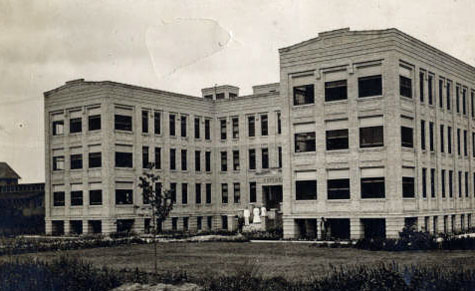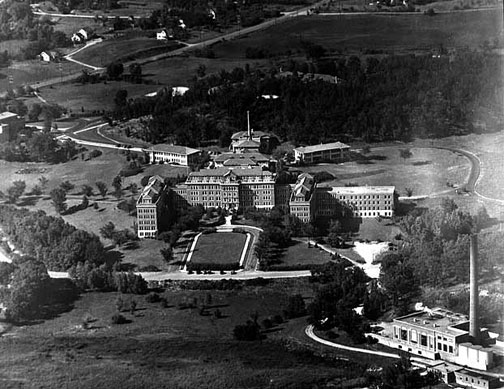Although Glen Lake was not situated in St. Louis Park, its residents were patients at the facility. Information for this section was taken in part from an article written by Betsy Adams.
Regarding patient records, researcher Mary Krugerud provides this information:
The Minnesota Historical Society has various records. Medical summary cards — which include patient name, age, stage of disease, discharge, and some other medical information — are closed for 50 years from date of creation. The cards are arranged by discharge year, so that complicates access. Patient information cards and medical meeting minutes are closed for 50 years from date of last entry. There are also admission and discharge records with restrictions. Even after 50 years they are not open to the general public because of data privacy laws. I am applying for access to restricted records as a researcher. I hope to finish a book about sanatorium life that I started about 20 years ago, and even access to the meeting minutes would be valuable. I have to sign an agreement to not disclose information on individuals, so I wouldn’t be able to help anyone out that way. Individuals can sign a similar application that specifies their relationship to a person and thus gain access for themselves or for a professional genealogist.
For information specific to St. Louis Park, see Public Health.
Tuberculosis, TB, or consumption as it was often called, is a bacterial infection that attacks the lungs, although it may also attack the kidneys, bones, lymph nodes, or the brain. It is generally transmitted though inhalation of bacteria-carrying air droplets. Its impact on Minnesotans was deadly: between 1887 and 1899, more than 20,000 Minnesotans had died of the disease.
1903
Dr. Henry Longstreet Taylor convinced the State to establish the first state tuberculosis sanatorium.
1906
Mrs. George H. Christian established a summer camp for children with tuberculosis on the Mississippi River near Lake Street in Minneapolis. In 1909 it was transferred to Glenwood Park.
1907
The first sanitarium in the State – the State Sanitarium for Consumptives – was opened in Walker, but was soon inadequate.
Hopewell-Parkview Hospital in Minneapolis opened specifically to treat victims of Tuberculosis. The new hospital, located in northeast Minneapolis, was described as “a shack or lean-to for 20 patients” in a pamphlet about Glen Lake. It was located in an isolated industrial area of the Camden neighborhood, overlooking the city workhouse, the garbage incinerator, and the brickworks on the Mississippi River.

Hopewell Hospital. Photo courtesy Minnesota Digital Library
1913
The State passed the Sanitarium Law, facilitating the construction and maintenance of county sanatoriums.
1914
Hennepin County began construction of what was to become the Glen Lake Sanitarium on land that spanned the Eden Prairie/Minnetonka border.
1916
On January 4, 1916, the first Tuberculosis patient was admitted to the East Cottage of Glen Lake Sanitarium, arriving on a sleigh during a raging snowstorm. At its opening, it had 50 beds in three cottages. The first Superintendent was Dr. H.O. Collins, who resigned in September. Dr. Ernest S. Mariette served from 1916 to 1949. Subsequent construction and events include:
1917
West Cottage opened, adding 50 beds
1921
Central section of main infirmary opened, adding another 100 beds
1922
Lenora Hall Christian Memorial Children’s Building built with funds donated by the Citizen’s Aid Society, adding 60 beds
1923
The Minneapolis Journal donated radio equipment to bring radio to every bedside.
1924
Major remodeling and expansion took place, adding the west infirmary wing, nurses’ home (Naysmith Hall), men employees’ building, staff wing (Townshend Hall), auditorium, dining hall, superintendent’s building, and power plant. Glen Lake had become an immense, modern medical facility, the largest in the State. By this time, all TB patients in Hennepin County were brought to this location. Hopewell Hospital was renamed Parkview Sanatorium and operated as a public charity hospital.
1925
Outpatient facilities established at the University.
The Glen Lake Children’s Camp opened in Eden Prairie on June 12, 1925, with the stated purpose “to provide a summer in the country for infected children to help them prevent their infection from developing into active disease.” That first year, 85 children, ages 4 to 14, attended the camp. The camp is still standing and listed on the National Register of Historic Places. See web sites on history and its current status.
1927
Despite outpatient care around the city, the facility was overcrowded and forced to use porch space to care for patients.
1929
The highest number of patients was recorded: 718.
1931
Vocational building built with funds donated by the Citizens’ Aid Society.
1938
Over 8,000 TB patients had been admitted. The grounds encompassed 160 acres. 1950: The Glen Lake Children’s Camp was closed.

Glen Lake campus, 1950. Courtesy Minnesota Historical Society
1955
East and West cottages closed for patient care.
1959
Children’s Building and several floors in the main building closed for patient care.
1961
The number of patients was 144. St. Louis Park resident S. Earl Ainsworth served on the Hennepin County Sanatorium Commission.
1962
With the advent of antibiotics, tuberculosis was no longer a deadly contagious disease, and the State’s sanitariums began to close. Leech Lake closed in 1962, its patients transferred to Glen Lake. At the same time, Oak Terrace Nursing home was opened at the Glen Lake site.
1976
The last TB patient was discharged from Glen Lake.
1993
The entire Glen Lake complex was demolished. It had served over 17,000 people in its 75 years.
The site is now a golf course.
